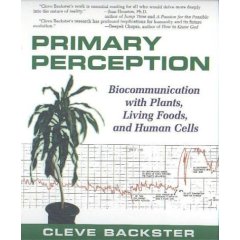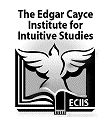| Edited by HENRY REED, Ph.D. |
May 25, 20088
|

Primary Perception: Biocommunication with Plants, Living Foods, and Human Cells
By Cleve Backster Book Summary by Susan Joseph You most likely are aware, from the experiments by Sir Jagadis Chandra Bose and others that plants respond favorably to certain types of music. But, do you know that the plant on your windowsill is “in-tune” with your thoughts and “anticipates” your return home, or that the unfertilized eggs in your refrigerator, the bacteria in yogurt, and cells removed from your body also respond to thoughts and actions? Although the scientific world has not yet fully embraced the existence of “biocommunication” between all living organisms, Cleve Backster’s experiments over the past 40 years, which he chronicles in “Primary Perception,” provide convincing evidence of the interconnectedness of all life. The Famous Dracaena PlantMr. Backster, who is a leading expert in polygraphing, traces his interest in biocommunication back to February 2, 1966 when, on a whim, he attached two small electrode pads connected to a polygraph machine to a leaf on a common houseplant, a dracaena plant, to determine how long it would take for water to travel from the roots to the leaf. However, instead of recording the expected decrease in electrical resistance due to the arrival of water, the polygraph record indicated just the opposite—it showed the same increased resistance seen when a human subject was experiencing a fear of detection. This intriguing pattern prompted Mr. Backster to try other techniques used to get responses from human subjects. Since sensitive questioning, which would be used on a human subject to determine if they were “hiding” something, would not work on a plant, Mr. Backster decided to see if he could “frighten” the plant by immersing one of its leafs in hot coffee. When there was no notable reaction, he thought about burning a leaf. The moment the image of a burning leaf entered his mind, the polygraph recording pen jump to the top of the chart, indicating real fear. This discovery set Mr. Backster upon a lifetime pursuit of conducting experiments to detect the reactions of plants, living foods, and animal cells to human thoughts. His efforts to publicize his findings have, quite frequently, elicited strong negative reaction from the scientific community and the public. Early ObservationsFor the following several years, Mr. Backster focused on refining his polygraph techniques for recording plant reactions. He varied the type of polygraph equipment used, varied the types of plants tested, and continually improved upon scientific protocol. Through his experimentation, Mr. Backster came to conclude that plants are a sensitive indicator of emotions emanating from other life forms in their immediate area, particularly the emotions of humans. The experiments also led to the following observations about plants: (1) Plants have the ability to discern true intent: The “threat” to do something harmful to the plant had to be real for the plant to respond. (2) Plants are territorial: A plant “defines” its territory and becomes attuned to the activity of life forces within that area. As such, if a plant defines its space as being two connected rooms, it may remain unaware of or tune-out activity in an adjacent room. (3) Plants develop an affinity for the person who takes care of them: This characteristic was discovered when the polygraph showed the plant appeared to anticipate Mr. Backster’s return to the laboratory the moment Mr. Backster decided to return. Further research showed that the plant only responded when there was a definite spontaneous decision to return, not if Mr. Backster merely thought he should return, but delayed his return. Furthermore, experiments showed that the plant’s perception was not affected by distance. Mr. Backster could be in the same building or miles away and the plant would perceive he was returning. (4) Plants appear to be very sensitive to the death of a wide variety of microscopic life forms: This characteristic was discovered accidentally when trying to account for unusual polygraph activity. It was traced to the moment that boiling water was poured down a sink drain after making coffee, killing the bacteria growing in the drain. Further experimentation showed that after exposing a plant to three or four repetitions of the pouring the boiling water, plant reaction subsided. Mr. Backster speculates that plants react to the injury or death of microscopic life forms because the forms emit some type of signal that the plants pick up as a potential threat to their well being; once a plant realizes there is no threat, as becomes evident if the event happens repeatedly, it stops responding with fear. (5) Plants retain sensitivity to injury or death of human cells: This discovery, too, was accidental and then later confirmed through experimentation. Mr. Backster observed plants responding to activities going on in an adjacent restroom, outside of their “territory.” Their reaction was eventually traced to the flushing of urinals with a disinfectant. The disinfectant was killing the living human cells in body fluids being excreted. However, unlike when non-human life forms were being injured or killed, repetition of the “killings” did not “desensitize” the plants. Based these observations of plant characteristics, Mr. Backster began to suspect that a plant’s perception or reaction to events was more basic, or primary, than traditional views on perception and led to his coining of the phrase “primary perceptions.” Mr. Backster also began to realize that, if he were to succeed in having his finds accepted by the scientific community and public, he would have to follow scientific methodology and expand his experiments beyond polygraph tests. The First Published ExperimentThe first experiment conducted following strict scientific methodology was designed to test whether plants reacted to the death of non-human life forms. Four polygraph machines were used—three attached to three different plants and the fourth, used as a control, was attached to a fixed value register. At random times, a machine designed by Mr. Backster would drop a cup of water containing brine shrimp into boiling water. Brine shrimp are raised as tropical fish food. The experiment showed that when the brine shrimp died, the electroded plants reacted on a statistically significant number of occasions. Mr. Backster presented the results of his experiment in September 1967 before the Parapsychology Association. In December 1967, the Journal of Parapsychology published an abstract on his plant research and, the following year, an article titled “Evidence of a Primary Perception in Plant Life,” was published in the Winter, 1968 edition of the International Journal of Parapsychology. Initial Reactions from the Scientists and the PublicWhen the results of the plant-brine shrimp experiment were published, there was intense public interest and interest from the scientific community. Mr. Backster became somewhat of a celebrity with invitations to present his findings at universities, scientific gatherings, and even before the Congress. When one small article appeared in a magazine, almost 5,000 scientists requested additional information on the experiment. His laboratory also became a popular site for many celebrities to visit and he appeared as a guest on the Johnny Carson, Art Linkletter, Merv Griffin, and David Frost shows. Mr. Backster’s celebrity status increased even more with the publication of the Secret Life of Plants by Peter Tompkins and Christopher Bird in 1972. His work also received praise from Eastern-block researchers and, in 1972, a Soviet scientist, V. N. Pushkin, reported he had duplicated Mr. Backster’s research with plants using a different type of machine, the EEG (electro-encephalograph), which is conventionally used for brain-wave monitoring. Many American researchers either avoided public commentary on his work or dismissed it as a waste of time or quackery. However, in 1975, Edgar Gasteiger of Cornell and John Kmetz of Science Unlimited Research Foundation reported Mr. Backster’s theory on psychic phenomena in plants had been disproved—that they had been unable to successfully replicate his experiments. Mr. Backster publicly challenged their work, noting problems in their approach, specifically that they had not followed proper automation of the experiment. They had had contact with the plants before conducting the experiment, thus compromising the experiment by allowing the plants to “attune” to the environment. Mr. Backster continued his research into “primary perception,” expanding the type of monitoring equipment used and the type of plants, but he did not attempt to replicate his plant-brine shrimp experiment. Some of his other experiments involved using eggs and yogurt with live bacteria and resulted in even more astounding discoveries. Observing EggsMr. Backster’s experimentation with eggs began after he determined plants in his laboratory were responding when he cracked open eggs. This led to the attaching of electrodes to an unfertilized egg. The polygraph recorded small but rapid cyclic serrations that looked like human pulse beats, except much more rapid, about 157 per minute—the same heart rate of a 3-day old chicken embryo. The question raised is whether this is a recording of the etheric field, that which would later guide the physical development of a pre-hatched chicken. With the use of electrocardiograph-type (EKG) instrumentation and electroencephalograph-type instrumentation, conventionally used for monitoring the heart and brainwaves, respectively, Mr. Backster discovered unfertilized eggs responded to the external environment. In one example, Mr. Backster abruptly picked-up his sleeping cat. At the moment the cat responded angrily, with claws extended, the egg showed increased activity. Eggs being monitored also responded when another egg was dropped into boiling water. This latter discovery of eggs responding to the “death” of another egg prompted an effort to design a “replicable” study of the phenomenon. For this experiment, an egg was electroded for an EKG recording and 10 eggs were dropped into boiling water at random times. However, instead of seeing a reaction to each “death,” the electroded egg reacted only to the first “death.” This experiment led Mr. Backster to speculate that when life forms are warned of impending death they go into a defensive state, the equivalent of fainting. He speculated that either the first egg dropped into the boiling or the electroded egg warned the other nine eggs of their impending death and they reacted defensively. If this is true, it could add greater insight into the saying of a grace before eating. Tuning in to Live BacteriaExperiments using yogurts showed “primary perception” in bacteria, that the bacteria in yogurt was very attuned to human interaction in the immediate area. In one experiment, Mr. Backster fed nutrients to a sample of yogurt taken from the yogurt that was “electroded.” The electroded yogurt responded as if it expected to be fed. Bacteria in yogurt also reacted when “unfriendly” bacteria on food “died” either from being heated or digested. However, as with the eggs, Mr. Backster speculated that when the first bacteria were terminated by the gastric juice, they warned the remaining bacteria as evidenced by the limited reaction in the yogurt. Experiments using yogurt also led to evidence that bacteria had an apparent capability to prioritize. Despite the chaos caused by having numerous in a room involved in varying activities, the bacteria in a yogurt was able to focus on what was happening to bacteria 15 feet away that was immersed in vodka. This suggests that there is a primary perception process, equivalent to “psychological set” in humans, but on a bacterial level. From Animal Cells to Human CellsHaving studied primary perception in plants, eggs, and bacteria, Mr. Backster moved on to studying primary perception in animal and human cells. These experiments showed that, like plants, animal and human cells: (1) are aware of and react to events affecting other living organisms, (2) react to injury or death of all other living organisms, (3) that human “thoughts” that will result in the injury or death of a living organism provide a type of notification to that organism that allows it to become “desensitized.” The experiments also showed that the cells remain “attuned” to the emotions and thoughts of the donor, i.e. to the person from whom the cells were taken. One of the first experiments involved a fresh beefsteak. EEG instrumentation detected reactions in an electroded beefsteak when a piece that was taken from it was being digested. It also reacted strongly when Ajax cleanser was poured on the cutting board used to slice the steak. Experiments also showed that a fresh beefsteak reacted to activities involving a piece of it that had previously been frozen, thus leading to the conclusion that freezing does not impair biocommunication capability. Conducting biocommunication experiments on human cells was the next challenge. The decision was made to experiment with oral leukocytes, commonly called “white cells,” because they could be easily collected from the mouth. Using a centrifuge to separate the cells from the saliva, the leukocytes were placed in a test tube into which a wire electrode was inserted. The electrodes were then connected to the EEG type instrumentation. Following are the results of some of the experiments included in a 1985 report Mr. Backster co-authored with two of his lab assistants entitled, Biocommunications Capability: Human Donors and In Vitro Leukocytes.
Biocommunication Research and Current Scientific AttitudesAlthough Mr. Backster has published and lectured extensively on his work, and a few laboratories have successfully replicated his experiments with human leukocytes, it has been difficult to achieve prescribed repeatability requirements required for the accumulation of acceptable empirical data on biocommunications. Most laboratories have yet to make the necessary changes in procedures to successfully conduct biocommunication experiments. The success of biocommunication experiments is dependent upon a degree of spontaneity as living organisms detect “thoughts” and therefore are able to prepare. The conventional planned research project, by design, has no spontaneity. Moreover, in biocommunication research, the intentions of the experimenter—negative or positive—can affect the results. If the right conditions can be achieved for serious research, there are many unanswered questions about biocommunication that merit study, particularly questions such as: (1) is there a distance limitation, (2) what is the speed of the communication transmission, and (3) is the communication capable of penetrating “shielding,” such as lead. Preliminary work indicates distance and shielding does not prevent biocommunication. If experiments find that biocommunication is faster than the speed of light or radio transmission, this could be beneficial for future space travel. Currently, using conventional communication methodology, there are transmission delays of 20 to 30 minutes. Also biocommunication work could provide support for the concept of “nonlocality” that is discussed by quantum physicists. If “nonlocality” existed, there would be no communication distance limitation and there there would be “zero time consumption.” Learning more about biocommunication could provide spiritual insights. Science has never provided a reasonable explanation concerning how prayer and meditation, particularly over vast distance, could be effective when the time required for such communication was confined to the speed of light. The concepts of a limitlessness biocommunication and “nonlocality” could explain how we communicate with God. Biocommunication research could advance holistic health care and explain why a patient’s attitude can affect medical outcomes. Experiments with leukocyte cells suggest that other cells of the body may also be influenced by the quality of a donor’s thought process and emotional state. It is possible that varieties of illness may result either from the expression or the suppression of negative thoughts or emotions. The capability for long-term monitoring, using biological sensors, opens possibilities for monitoring under a wider variety of circumstances, such as when a donor is undergoing surgery, attending therapy sessions, pre-testing television shows, or while playing sports. More advances in technology may allowing monitoring crops or giant redwoods, for example. Mr. Backster strongly believes that the key to acceptance of biocommunication among all living things is enabling as many as want to experience their own observation of biocommunication at work. Currently, such observations require sophisticated equipment, such as polygraph machines or EEG and EKG type instrumentation. A possible long range solution to this problem entails making available to the curious and open-minded individuals a comparatively inexpensive EEG-type device which will be portable and, most likely, battery powered. Mr. Backster is working on developing such a device, partially financed from his share of the sales of Primary Perception. |




